There is an endless list of ways in which you can “be more green,” but don’t feel that you need to do them all in order to have a positive impact. Every little bit helps! The following list includes some very simple tasks to ideas with limitless possibilities. You needn’t spend a fortune in order to be green. Some of the ideas below are free, and many will save you money!
1. Replace ALL of Your Bulbs with LED Lights
LED – Light-Emitting Diode – bulbs have life spans of about 25,000 hours and emit very little heat, which is a huge improvement over traditional incandescent bulbs which only last for about 1,200 hours and emit quite a bit of heat. Switching to LED bulbs will definitely save you money over time even if they are more expensive up front. Not only do you have to purchase far fewer of them, but your air conditioning doesn’t have to do the extra work of counteracting the heat produced by incandescent bulbs. Switching to LED bulbs is one of the best things you can do to save energy and money. Here is an excellent article comparing LEDs to CFLs and incandescents.
When purchasing LED bulbs, keep in mind that “TEP pays manufacturers to provide discounts on light-emitting diode (LED) bulbs that are passed along by local retailers at the time of purchase. No coupons are necessary, and discounted bulbs are available from multiple retailers.” Those local retailers are Lowes, Home Depot, and Walmart.
2. Don’t Heat or Cool Your House When You’re Not Home
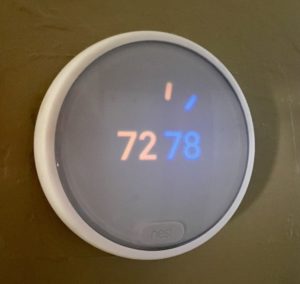 It’s more energy efficient to only heat or cool your home when you need it rather than keeping it at the same temperature all day. Having to remember to keep turning your thermostat on and off is not practical, so a smart programmable thermostat is the solution. There are a few different brands out there, but the Nest is the only one that is eligible for a rebate from Tucson Electric Power. They cost $169 or $249 each, depending on the model, and the TEP rebate is for $35 each. You’ll need one for each thermostat in your home. I ordered them online and was able to install them myself.
It’s more energy efficient to only heat or cool your home when you need it rather than keeping it at the same temperature all day. Having to remember to keep turning your thermostat on and off is not practical, so a smart programmable thermostat is the solution. There are a few different brands out there, but the Nest is the only one that is eligible for a rebate from Tucson Electric Power. They cost $169 or $249 each, depending on the model, and the TEP rebate is for $35 each. You’ll need one for each thermostat in your home. I ordered them online and was able to install them myself.
The Nest thermostats themselves can sense motion nearby and use that to determine if you’re home or not, but I don’t think that would be particularly reliable in my home, so we use the other method which is tying them to our phones. Any time that both of our phones are outside of our home’s Wifi coverage, the Nest thermostats turn to Away mode which is set to use Eco Temperatures, a much wider range of 60-85 degrees Fahrenheit rather than the 72-78 range while we’re home. Usually this means the HVAC won’t run until we return home. Because the Nests are controlled from our phones, we can always set them back to normal temperatures before we arrive so that the home isn’t shockingly cold or hot when we walk in.
Another feature of the Nest that I really like in the winter is that early in the morning it heats your house up to the temperature you want it at, just in time for you to wake up (assuming you tell it those wake up times). The Nest learns how long it takes your home to heat up and takes into consideration the current indoor and outdoor temperatures. No longer do you program the thermostat (also done conveniently from your phone) to switch to different temperatures at different times of day but rather for the home to BE at different temperatures at different times of day. It takes the guesswork out of it and uses just the right amount of energy to keep you comfortable.
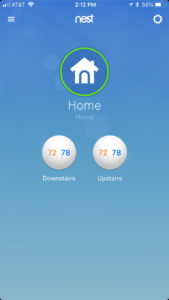 .
. 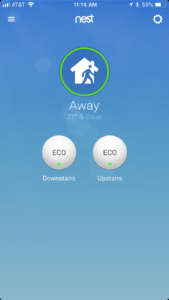
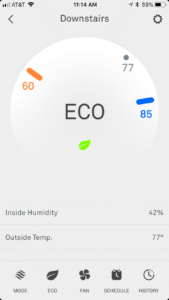 .
. 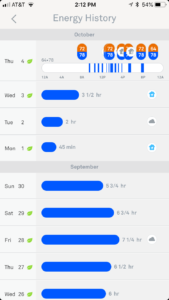 .
.
3. Reduce Your Shower Times
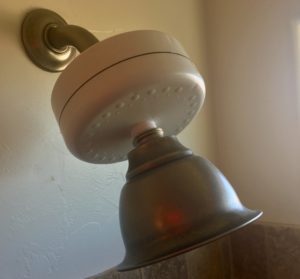
Water is precious, and the longer your shower, the more water you’re using. Kids are notorious culprits when it comes to unending showers, so a handy device like the Shower Manager can be helpful in setting clear limits for them. I wrote an entire blog post about why and how to use a Shower Manager. You can purchase them online for $149 for one, $260 for two, or $360 for three and install them yourself.
If you’d rather not limit the length of the shower but limit the water that comes out of the shower head instead, you can purchase a Watersense Qualified Shower Head, and Southwest gas provides a $5 rebate for them.
4. Avoid Throwing Food in the Trash
Once food hits the landfill, it emits methane, one of the worst greenhouse gases, because with trash piled on top of it, the food does not get exposed to oxygen was it decomposes. Rather than put your food in the trash, compost it! There are some rules of course. Animal products (meats & dairy) will still need to go in the trash, as they will stink up your compost bin and attract pests, but fruits, vegetables, and grains are all fair game. Even egg shells can be composted.
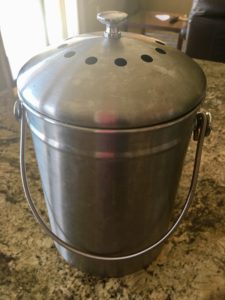
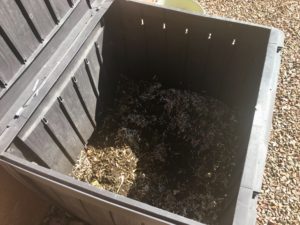 Here’s how it works: We put our eligible food scraps in a small stainless steel bin under the sink as we collect them, and once that fills up, we dump it into the compost bin in the backyard. When we first got the bin from Home Depot, we added about 6 inches of sticks in the bottom to create space for air. The bin doesn’t smell, and it looks inconspicuous.
Here’s how it works: We put our eligible food scraps in a small stainless steel bin under the sink as we collect them, and once that fills up, we dump it into the compost bin in the backyard. When we first got the bin from Home Depot, we added about 6 inches of sticks in the bottom to create space for air. The bin doesn’t smell, and it looks inconspicuous.
Foods are “green” material, and on occasion you’ll need to add about twice as much “brown” material, which can include dried leaves, dried grass clippings, coffee grounds, wood shavings, shredded paper (our go-to “brown” material), and other materials which are easily researched online. About twice per week, we use a shovel to stir it all up in the compost bin (that exposure to oxygen is critical), and we add some water if it’s particularly dry. A few times per year we add some bagged organic soil.
Once you get set up, the whole thing is actually pretty low maintenance, and you get the added benefit of top-notch organic material to add to your garden. Every time I plant something, I mix some compost (aiming for the dark, even material and avoiding any chunks that haven’t decomposed yet) with potting soil, and my plants thrive with this combination. After years of composting regularly, it’s amazing how our bin has not come even close to filling up, so don’t worry about running out of space!
If you live in an apartment or just don’t want to deal with all of this, you can pay local company Scraps on Scraps $16 per month to pick up your compostable materials.
5. Extend the Life of Your Electronics and Appliances
Reduce. Reuse. Recycle. In that order. Reducing the number of appliances you go through in a lifetime is better for the environment than just relying on recycling them each time you need to get a new one. We recently lost our refrigerator to a power surge, so we had to replace it. It died young. With a whole house surge protector, you can protect everything in your home without surge protectors hanging out of every outlet. We recently got a quote from a local electrician for $299 which includes parts and installation. Not bad when you consider it could have saved us a refrigerator!
6. Reduce Your Plastic Bag Usage
Plastic bags cannot be recycled, and they are not biodegradable. It’s no secret nowadays that plastic bags are downright terrible for the environment. Although you cannot put them in your recycling bin, you can return them to your grocery store, and they will recycle them…into more plastic bags. Unfortunately, these recycled bags are thinner, requiring more items to be double bagged. More bags! Once again – Reduce. Reuse. Recycle. In that order. Reducing your plastic bag usage is far superior to recycling them.
Get out of this messy plastic bag cycle all together, and start using reusable cloth bags. They are available for purchase at grocery stores, and you may already have some that will work, from conferences, expos, and various vendors. You can even use an Albertson’s bag at Safeway (I’ve done it). Nobody cares. Just don’t take the plastic ones!
Forgot your reusable bags at home or in the car? Take one for the team and put your groceries directly into your cart and car (it helps to have a box or organizer in your trunk to keep things from sliding around). You can always transfer your groceries into the bags when you get to the car or when you get home before carrying them inside. Just avoid taking on more plastic bags!
7. Educate Yourself About Passive & Active Rainwater Harvesting
 Rainwater harvesting projects can range from small changes to your landscaping to large expensive cisterns with lots of options in between. Your opportunities depend a lot on your home, your yard, and your water needs. To learn more about what might work well for you, visit Watershed Management Group’s Living Lab located at Speedway and Dodge (1137 N. Dodge Blvd). Not only is it the local non-profit’s headquarters, but it also serves as a model for all kinds of rainwater harvesting as well as other water-saving measures like gray water usage, composting toilets, and native plant selection. You can take a free tour, and they have lots of fun and educational public events to attend. Tucson Water also offers rebates if you decide to move forward with a project at your home:
Rainwater harvesting projects can range from small changes to your landscaping to large expensive cisterns with lots of options in between. Your opportunities depend a lot on your home, your yard, and your water needs. To learn more about what might work well for you, visit Watershed Management Group’s Living Lab located at Speedway and Dodge (1137 N. Dodge Blvd). Not only is it the local non-profit’s headquarters, but it also serves as a model for all kinds of rainwater harvesting as well as other water-saving measures like gray water usage, composting toilets, and native plant selection. You can take a free tour, and they have lots of fun and educational public events to attend. Tucson Water also offers rebates if you decide to move forward with a project at your home:
- Rainwater Harvesting Rebate (Tucson Water): Up to $2000
- Gray Water Rebate (Tucson Water): Up to $1000
8. Don’t Bag Your Recycling
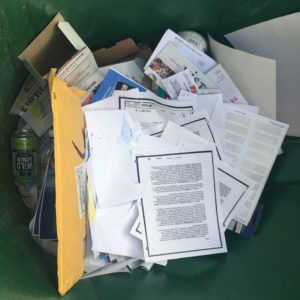
We bag our trash, so bagging our recycling seems like the logical thing to do. Recyclables have to be sorted though, so they’re just going to come out of that bag anyway, taking more time and money (which will be passed on to customers) to handle it all. The City of Tucson explicitly says, “All recyclables go loose into the Blue Barrel, together – – no sorting! Please put them in individually, not inside a box or bag.” Don’t risk your bag of recyclables being thrown into the trash instead!
And while you’re at it, make sure you’re clear on what can and cannot be recycled by printing out this handy list.
9. Plant a Tree
Shade trees help cool your home, make your yard more enjoyable, reduce the urban heat island effect, prevent erosion, and of course turn carbon dioxide into oxygen like we all learned in science class. You can get heavily discounted shade trees from Tucson Electric Power’s Trees for You Program. Make sure to plant them far enough from your home so that their roots don’t interfere with your plumbing or foundation as they grow.
10. Take Advantage of Rebates from Local Utilities
Tucson Water, Tucson Electric Power, and Southwest Gas each encourage environmentally friendly upgrades by provide a number of rebates to their customers, but those rebates change often, so check out their websites for the most up to date lists. Here they are as of 10/5/18:
- High Efficiency Toilet Rebate (Tucson Water): $75 per toilet, $150 for two toilets
- Watersense Qualified Shower Head Rebate (Southwest Gas): $5
- Clothes Washer Rebate (Tucson Water): $200
- Front Loading Clothes Washer Rebate (Southwest Gas): $50
- Rainwater Harvesting Rebate (Tucson Water): Up to $2000
- Gray Water Rebate (Tucson Water): Up to $1000
- Smart Thermostat Rebate (Tucson Electric Power): $35 per Nest
- Energy Star AC/Heat Pump Rebate (Tucson Electric Power): Up to $575
- Energy Star AC/Heat Pump Installation Rebate (Tucson Electric Power): Up to $375
- Duct Sealing Rebate (Tucson Electric Power): Up to $300
- Refrigerant Charge Repair Rebate (Tucson Electric Power): $70
- Indoor Coil Cleaning Rebate (Tucson Electric Power): $40
- Outdoor Coil Cleaning Rebate (Tucson Electric Power): $25
- Western Cooling Control Rebate (Tucson Electric Power): $70
- Solar Water Heater Rebate (Southwest Gas): Up to $2000
- Energy Star Windows Rebate (Southwest Gas): Up to 75% of equipment cost
Living green is near and dear to my heart. I’m always seeking out new ways to do it. Because of my passion for sustainable living, I hold NAR’s Green Designation which “provides advanced training in green building and sustainable business practices so that you can seek out, understand, and market properties with green features.” Stay tuned to TeamWoodall.com for additional insights into green living.



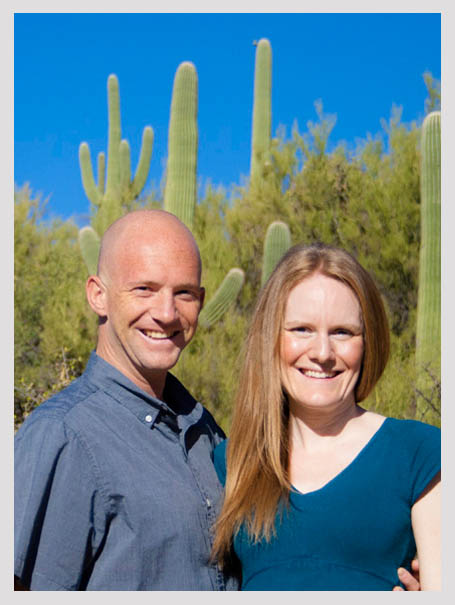




Connect With Us!